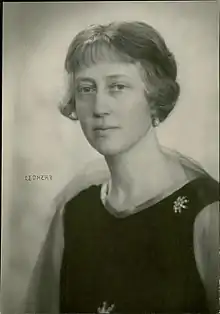Louise Nathalie Adelborg | |
|---|---|
 | |
| Born | 2 July 1885 Ludgo, Sweden |
| Died | 9 September 1971 Stockholm, Sweden |
| Burial place | Norra begravningsplatsen |
| Nationality | Swedish |
| Alma mater | Technical School in Stockholm |
| Occupation(s) | Porcelain designer, textile artist |
| Parents |
|
Louise Nathalie Adelborg (2 July 1885 – 9 September 1971) was a Swedish porcelain designer and textile artist.
Biography
Louise Adelborg was born in Ludgo, Södermanland County, Sweden, a member of the noble Adelborg family. She was the daughter of Jacquette De Geer and Otto Ehrenfrid Adelborg, a Swedish Army captain. Her brother Fredrik became a diplomat, and her brother Gustaf-Otto became a writer.
She graduated from the Technical School in Stockholm, following up with study trips to Italy and France. She began exhibiting ceramics and embroidery in 1916, and around the same time was tapped as a designer of patterns for the Rörstrand porcelain factory. She continued working for them until 1957, developing into a highly respected designer known for "an understated yet graceful modernism".[1] Patterns she developed include Vase (1923) and the National Service (ca. 1930).[2][3] National Service, later renamed Swedish Grace, features a wheat-ear motif and was exhibited at the Stockholm exhibition of 1930.[2][4] Swedish Grace is still in production and considered an iconic design.[2][5]
She was also greatly interested in embroidery and textile art. She created a number of textiles with religious motifs for church use, including an antependium for the Riddarholm Church. She also designed patterns for fabrics from Almedahl-Dalsjöfors.
Adelborg's work is held by the National Museum in Stockholm.
She was a member of the women's association Nya Idun.[6] Adelborg was awarded the Illis quorum in the fifth size.[7]
She died in 1971 in Stockholm and is buried at Norra begravningsplatsen ('Northern Cemetery') outside Stockholm.
References
- ↑ Opie, Jennifer Hawkins (1990). Scandinavia--ceramics & glass in the twentieth century: the collections of the Victoria & Albert Museum. Rizzoli.
- 1 2 3 "Louise Adelborg". Rörstrand.
- ↑ The Bloomsbury Encyclopedia of Design. Bloomsbury Publishing Plc. 2016. pp. 172, "Rörstrand, ". doi:10.5040/9781472596154-bed-r054. ISBN 978-1-4725-9615-4.
- ↑ Hamilton, William (February 3, 2000). "CURRENTS: THE GIFT SHOW; Bringing Back A Swedish Classic". The New York Times.
- ↑ Swengley, Nicole (October 3, 2010). "Style with northern soul; Clean lines and sharp colours keep Scandinavian design at the cutting edge of cool". The Sunday Telegraph (London).
- ↑ "Louise Adelborg". nyaidun.se (in Swedish). 2015-05-26. Retrieved 2022-04-17.
- ↑ Carlgren, Maria. "Louise Nathalia Adelborg". Svenskt kvinnobiografiskt lexikon. Translated by Alexia Grosjean. Retrieved 2022-06-01.